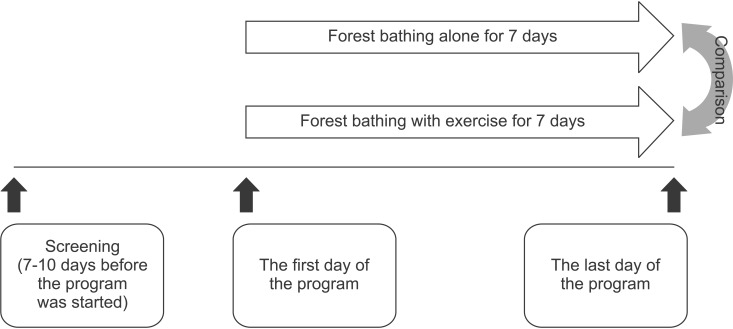Ann Rehabil Med.
2015 Dec;39(6):957-963. 10.5535/arm.2015.39.6.957.
Relief of Chronic Posterior Neck Pain Depending on the Type of Forest Therapy: Comparison of the Therapeutic Effect of Forest Bathing Alone Versus Forest Bathing With Exercise
- Affiliations
-
- 1Department of Rehabilitation Medicine, Hanyang University College of Medicine, Seoul, Korea. sibopark@hanyang.ac.kr
- 2Department of Integrative Medicine, Korea University College of Medicine, Seoul, Korea.
- KMID: 2165622
- DOI: http://doi.org/10.5535/arm.2015.39.6.957
Abstract
OBJECTIVE
To compare the pain-reducing effect of forest bathing alone versus forest bathing in combination with stretching and strengthening exercises in patients with chronic posterior neck pain.
METHODS
Sixty-four subjects with posterior neck pain that had lasted more than 3 months were enrolled. They were randomly divided into a forest bathing alone (FBA) group and a forest bathing with exercise (FBE) group; each group included 32 subjects. All subjects from both groups walked every morning in the forest for about 2 hours for 5 days. In the afternoon, the FBE group did a stretching and strengthening exercise for about 4 hours; the FBA group had free time in the woods. Visual analog scale (VAS) on one day, VAS over the previous week, neck disability index (NDI), EuroQol 5D-3L VAS (EQ VAS) and index (EQ index), McGill pain questionnaire (MPQ), the number of trigger points in the posterior neck region (TRPs), and the range of motion of the cervical spine were evaluated on the first and last day of the program and compared between the two groups.
RESULTS
The number of TRPs were significantly reduced in the FBE group compared with the FBA group (p=0.013). However, the other scales showed no significant difference between the two groups.
CONCLUSION
When patients with chronic posterior neck pain underwent a short-term forest bathing (less than 7 days) program, FBE was more effective in the reduction of the number of TRPs than FBA. However, all other pain measurement scales we evaluated showed no statistically significant difference between the two protocols.
MeSH Terms
Figure
Reference
-
1. Bronfort G, Evans R, Nelson B, Aker PD, Goldsmith CH, Vernon H. A randomized clinical trial of exercise and spinal manipulation for patients with chronic neck pain. Spine (Phila Pa 1976). 2001; 26:788–799. PMID: 11295901.
Article2. Cote P, Cassidy JD, Carroll L. The Saskatchewan health and back pain survey: the prevalence of neck pain and related disability in Saskatchewan adults. Spine (Phila Pa 1976). 1998; 23:1689–1698. PMID: 9704377.3. Braddom RL. Physical medicine and rehabilitation. 4th ed. Philadelphia: Saunders/Elsevier;2011.4. Irnich D, Behrens N, Gleditsch JM, Stor W, Schreiber MA, Schops P, et al. Immediate effects of dry needling and acupuncture at distant points in chronic neck pain: results of a randomized, double-blind, sham-controlled crossover trial. Pain. 2002; 99:83–89. PMID: 12237186.
Article5. Aker PD, Gross AR, Goldsmith CH, Peloso P. Conservative management of mechanical neck pain: systematic overview and meta-analysis. BMJ. 1996; 313:1291–1296. PMID: 8942688.
Article6. Wheeler AH, Goolkasian P, Gretz SS. Botulinum toxin A for the treatment of chronic neck pain. Pain. 2001; 94:255–260. PMID: 11731062.
Article7. Li Q. Effect of forest bathing trips on human immune function. Environ Health Prev Med. 2010; 15:9–17. PMID: 19568839.
Article8. Lee J, Park BJ, Tsunetsugu Y, Ohira T, Kagawa T, Miyazaki Y. Effect of forest bathing on physiological and psychological responses in young Japanese male subjects. Public Health. 2011; 125:93–100. PMID: 21288543.
Article9. Sung J, Woo JM, Kim W, Lim SK, Chung EJ. The effect of cognitive behavior therapy-based "forest therapy" program on blood pressure, salivary cortisol level, and quality of life in elderly hypertensive patients. Clin Exp Hypertens. 2012; 34:1–7. PMID: 22007608.
Article10. Park HS, Shin CS, Yeoun PS, Kim JY. A comparative study of the stress recovery effect of forest therapy. J Korean Ins For Recreation. 2014; 18:13–24.11. Lee SI, Shin WS, Kwon YM, Kwon HG. The effect of woods aromatic substance. J Korean Ins For Recreation. 2003; 7:25–29.12. Shin YK, Baik JH, Chae JH. Application of environmental therapy: focused on forest therapy and hydrotherapy. Korean J Stress Res. 2010; 18:167–179.13. Ylinen J. Physical exercises and functional rehabilitation for the management of chronic neck pain. Eura Medicophys. 2007; 43:119–132. PMID: 17369784.14. Douglass AB, Bope ET. Evaluation and treatment of posterior neck pain in family practice. J Am Board Fam Pract. 2004; 17 Suppl:S13–S22. PMID: 15575026.
Article15. Reips UD, Funke F. Interval-level measurement with visual analogue scales in Internet-based research: VAS Generator. Behav Res Methods. 2008; 40:699–704. PMID: 18697664.
Article16. Vernon H, Mior S. The Neck Disability Index: a study of reliability and validity. J Manipulative Physiol Ther. 1991; 14:409–415. PMID: 1834753.17. Szende A, Oppe M, Devlin NJ. EQ-5D value sets: inventory, comparative review and user guide. Dordrecht: Springer;2007.
- Full Text Links
- Actions
-
Cited
- CITED
-
- Close
- Share
- Similar articles
-
- Literature Review of Forest Healing Therapy on Korean Adults
- Systematic Review of Forest Therapy Program for Adult Patients with Diseases
- Efficacy of Forest-Thermal Combined Therapy for Anxiety and Stress among Smoking-Cessation Attempters
- The Effect of Cognitive Behavior Therapy-Based Psychotherapy Applied in a Forest Environment on Physiological Changes and Remission of Major Depressive Disorder
- A Systematic Review of Forest Therapy Programs for Elementary School Students


